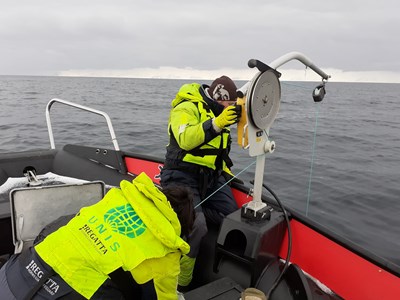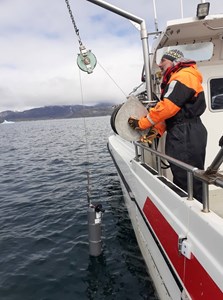By Tobias R Vonnahme
Long-term monitoring programs are key to understand ecosystem changes in a changing climate. Nuup Kangerlua outside Nuuk (Greenland Climate Research Centre, GCRC, since 2005), and Adventfjorden (University Centre in Svalbard, UNIS, since 2010) outside Longyearbyen have some of the longest year-round marine monitoring programs in the Arctic. Comparing time series on different locations across the Arctic can be powerful for detecting changes, trends, and their drivers not only in a local perspective, but in a pan-Arctic context. However, the methods must be comparable or differences in the methods must be known in detail, to allow comparability. The overall aim of the mobility was to compare and standardize the marine ecosystem monitoring sampling methods across the institutions.

From the 18th of May until the 5th of June 2022, I went to Svalbard to join their monthly monitoring program on Svalbard and learn their sampling and analyses methods in close collaboration with Janne Søreide, Chestaa Chitkara, and Sebastian Andersen. In addition, I established a method for measuring primary production, that we are using in Greenland (P vs I curves using 14C-DIC tracers in the lab), and that will be integrated in the Svalbard time series. For comparing the systems in more detail, I took additional samples at 15 stations over Isfjorden, similar to the monthly May transect we are doing every year in Nuup Kangerlua. With the additional samples I aim to identify common drivers for spatial variability in phytoplankton and zooplankton diversity. We also included several Master and PhD students in the sampling campaigns for teaching the methods, and I gave lecture for the Department of Arctic Biology about our work in Greenland.

Following my visit in Svalbard, Anna Vader and Børge Damsgård from UNIS visited us in Nuup Kangerlua and joined our monitoring program in the field and in the lab. During a meeting together with Thomas Juul-Pedersen after the field work we discussed differences in our methods and what that means for comparability and discussed possible changes in our methods that would make the time series programs to allow comparability. For example, UNIS will try to regulate their vacuum for Chlorophyll filtration using a pressure gauge and flow restrictor, we will add different mesh sizes for Zooplankton sampling, and we will use the same DNA extraction protocol and use the same company for sequencing our DNA samples.
